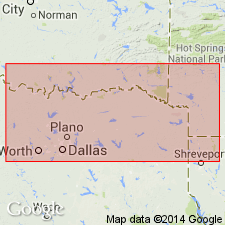
- Usage in publication:
-
- Trinity formation
- Modifications:
-
- Named
- Dominant lithology:
-
- Sand
- Marl
- AAPG geologic province:
-
- Ouachita folded belt
- Arkla basin
- East Texas basin
Summary:
Named as a formation for the Trinity Rivers present in it. No type locality given. Occurs in the southwest corner of AR and "south-eastern Indian Territory," and in northeastern TX, in the Ouachita tectonic belt province, Arkla basin, and East Texas basin. Except for a few mi on each side of Red River, its width is never more than a few mi. Consists of alternations of fine, closely packed white sands and red and blue gypsiferous marls, with occasional alternations of thin but extensive, fissile, arenaceous, and crystalline limestones which are highly fossiliferous and often wave-marked. Thickness of the limestone beds is seldom more than 10 in. [Thickness of entire formation not given.] In places, extensive strata of pure saccharoidal gypsum also occurs. Overlies Carboniferous; underlies Cretaceous. West of Weatherford [Johnson Co, TX], the Comanche series rests on the Trinity. Fauna of the formation is littoral and of great uniformity throughout its extent; mollusks; dinosaur remains found in TX. Of Early Cretaceous age and "perhaps Jurassic."
Source: GNU records (USGS DDS-6; Denver GNULEX).
For more information, please contact Nancy Stamm, Geologic Names Committee Secretary.
Asterisk (*) indicates published by U.S. Geological Survey authors.
"No current usage" (†) implies that a name has been abandoned or has fallen into disuse. Former usage and, if known, replacement name given in parentheses ( ).
Slash (/) indicates name conflicts with nomenclatural guidelines (CSN, 1933; ACSN, 1961, 1970; NACSN, 1983, 2005, 2021). May be explained within brackets ([ ]).

